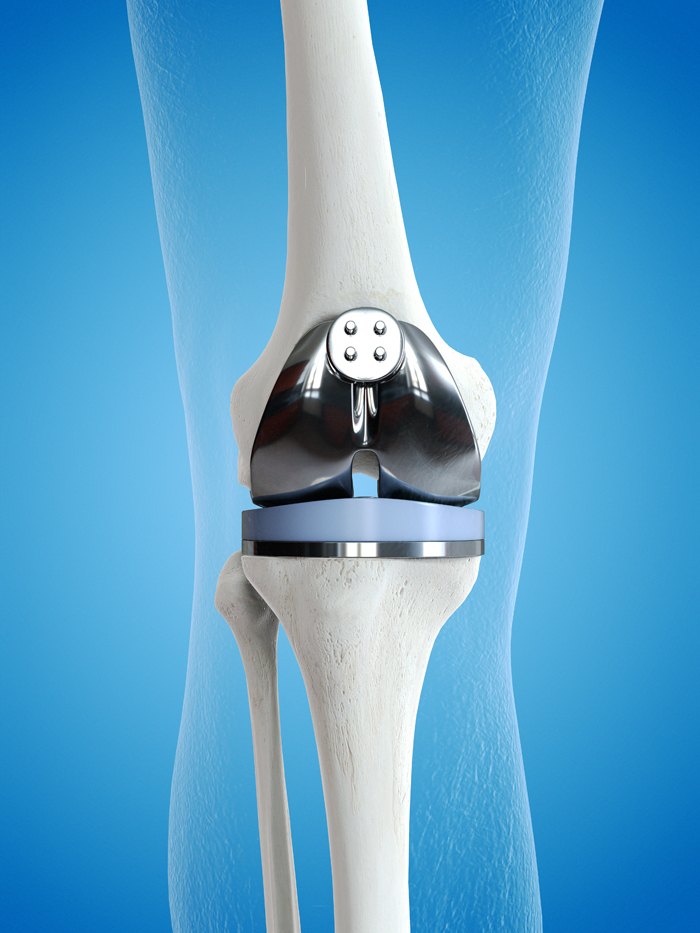Knee Replacement Surgery in Kondapur, Hyderabad
Also known as knee arthroplasty, knee replacement is a surgical procedure wherein the damaged cartilage and bone of the knee joint are removed and replaced with a prosthesis (artificial joint).
What is Knee Replacement Surgery?
During knee replacement surgery, the damaged parts of the knee are removed and replaced with an artificial joint called a prosthesis, which is made of plastic and metal. The prosthesis is then attached to the kneecap, thighbone, and shinbone using special material, to hold everything in place.

Why is Knee Replacement Done?
The main reason for getting knee replacement surgery is to get relief from pain and inflammation in the knee joint, which leads to disability, discomfort, and not being able to perform daily activities. Many conditions can cause this, including;
- Osteoarthritis - Pain, and inflammation in the knee joint most commonly occur due to osteoarthritis. In this condition, the cartilage wears away, with age and due to this, bones rub against each other. This causes pain, swelling, and inflammation in the joint.
- Deformities – People who are born with knee deformities such as bowed legs or knock-knees, may need to get knee replacement to reposition the knee correctly.
- Knee injuries – Sometimes, knee injuries such as ligament tears or fractures due to an accident or a bad fall can cause arthritis. This can cause limitations in movement and pain, requiring knee replacement surgery.
- Rheumatoid arthritis – RA is an autoimmune condition wherein the body’s immune system mistakenly starts to attack and destroy the knee’s joint lining. This might require knee replacement surgery.
How is Knee Replacement Surgery Done?
Knee replacement surgery can be of five types;
- Partial knee replacement – This surgery is performed if arthritis affects only one side of the knee.
- Total knee replacement – This is the most common type of knee replacement procedure. In this surgery, the surfaces of the shin bone and thigh bone that connect to the knee are removed and replaced.
- Patellofemoral replacement – In this procedure, only the groove in which the kneecap sits and its under-surface are replaced.
- Cartilage restoration – IN this procedure, the isolated area where cartilage damage or injury has occurred, is replaced with living cells or cartilage grafts that grow into cartilage.
- Revision knee replacement – This procedure may be performed if an individual has severe arthritis or they’ve previously had two or more knee replacement procedures.
During knee replacement surgery, the patient will first be given either general or spinal anaesthesia. After this, the patient’s knee will be bent in such a way that all surfaces of the knee joint are exposed. Then, the surgeon at Apollo Kondapur will make an incision. After this, they will move aside the kneecap and remove the damaged cartilage and bone. These parts are then replaced with the pieces of prosthesis (artificial joint). All the parts are attached with special glue. Before closing the incision with stitches, your surgeon will rotate and bend your knee to ensure that it is functioning properly.
What Happens After Knee Replacement Surgery?
After knee replacement surgery, the patient will be taken to a recovery room where they’ll be kept under observation for one to two hours. Most patients have to stay in the hospital for a few days after their knee replacement surgery. They are likely to experience pain after surgery for which the doctor would prescribe medication.
Patients are recommended to move the ankle and foot during their stay at the hospital. This encourages blood flow to the muscles and also helps prevent blood clots and swelling. Patients would also have to wear compression boots or a support hose to avoid clots and swelling. They can increase their activity level gradually. They would also have to perform certain exercises as taught by a physical therapist to slowly regain strength and mobility in their knee.
Request an appointment at Apollo Spectra Hospitals, Kondapur
Call 1860-500-2244 to book an appointment
What are the Complications Associated with Knee Replacement Surgery?
As with any major surgery, some complications may arise after knee replacement surgery, such as;
- Excessive bleeding
- Blood clots
- Damage to nearby blood vessels or nerves
- Infections
- Stroke
- Heart attack
Most people find relief from pain and inflammation after knee replacement surgery. They’re also able to get back to their daily activities with improved functioning and mobility. Knee replacements can last up to 15 years for most people.
You might have to take several steps after knee replacement for quicker and safer recovery. These steps include –
- Using a walker or crutches for a few weeks after surgery
- Having help with daily activities such as bathing and cooking
- Not climbing stairs for a few weeks
- Having stairway handrails for support
- Handrails or safety bars in the bath or shower for support
- Chair or bench for shower
- Getting rid of rugs and cords to avoid falling
- Keeping the leg elevated
Knee replacement surgery can last around two hours.
If you have any of the following signs, you should contact your doctor immediately –
- Fever above 100 degrees Fahrenheit
- Drainage from the incision site
- Chills
- Swelling, redness, pain, or tenderness in the knee
Symptoms
Our Top Specialities
NOTICE BOARD
CONTACT US
CONTACT US
 Book Appointment
Book Appointment


.svg)
.svg)
.svg)
.svg)








